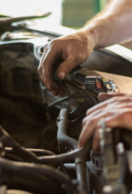The safety features in automobiles are getting more and more sophisticated by the year, and the percentage of drivers utilizing them is growing every year, as well. Yet car crashes and fatalities behind the wheel only continue to rise. With all the incredible tech designed to keep us safe, why aren't we any safer?
Distraction
It's great to have a safe, reliable vehicle, but the most important tool behind the wheel is you, the driver. If you are tuned in to what is going on around you, ready to brake, change lanes, swerve, etc. at a moment's notice, then you will optimize your own safety and the safety of the other drivers on the road.
However, distracted driving is becoming more the norm than the exception, and it's increasingly common to see blatantly inattentive drivers. Texting, talking, and even using the navigation feature on smartphones is a significant distraction for everyone from new teenage drivers to adults. If you're looking to improve the safety of your family on the road, start with a firm rule of no phone usage while driving.
Reliance on Safety Features
Another factor in these worsening statistics seems to be the vehicle safety features themselves. With fancy features like backup cameras, blind spot monitoring, lane departure warnings, and forward collision braking, we can almost feel like we are driving a driverless car, and become lax with the basic rules of driving safety.
With or without tech keeping you safe inside the car, here are a few tried and true basics that you should never forget.
- Wear that seat belt. It's been said so many times that we almost tune it out, but it's one of the most important factors in determining survival in a car crash. Just wear it.
- Don't tailgate. We've all heard that "three cars' lengths" and"two-second" safety rules, but it can be easy to let it slide when you're in a hurry or the car in front of you is driving like a snail. Be patient. Tailgating causes anxiety for the driver in front of you, which can lead them to make unsafe driving maneuvers, or it could lead you to rear-ending them if you can't stop in time. Wait for a safe time and place to pass.
- Don't speed.
 Speed limits are laws, and breaking them will get you a fine, but you've also got a much higher chance of a collision crash when the car in front of you slows down or you don't see something in the roadway. These limits are set with safety in mind, both for you as a driver and for the community through which you are driving.
Speed limits are laws, and breaking them will get you a fine, but you've also got a much higher chance of a collision crash when the car in front of you slows down or you don't see something in the roadway. These limits are set with safety in mind, both for you as a driver and for the community through which you are driving. - The passing lane is for passing. Avoid driving in the left lane. While many call it the "fast lane," it is actually only designed to serve as a temporary lane until you can get back over. In most states, you legally must get back into the center or right lane if you are not actively passing someone.
- Use your turn signals. This is the best way to communicate with other drivers on the road to let them know your intentions. Even if you don't see anyone in the lane next to you, things can change on the roadway pretty quickly, and it's good for those around you to know what to expect.
- Check your blind spots. Mirrors, cameras, and blind spot detectors are all fallible. Check all your mirrors and turn to look before getting over. Too many motorcyclists have been overlooked by drivers who didn't double-check.
Drive Safe
Next time you get on the road, take a bit of extra care for your safety and the safety of those around you. Don't let the little things slide, and don't be distracted. To keep your vehicle safe to drive, call All in the Wrist Auto Repair for all your maintenance and repair needs.








